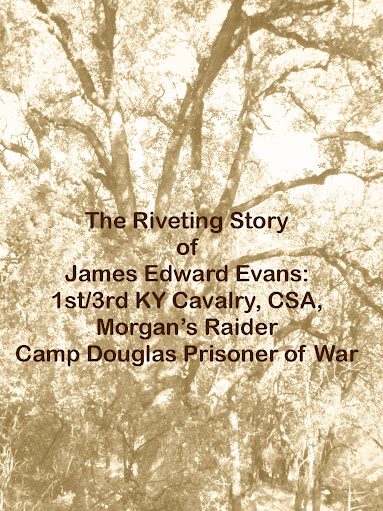Another difficulty was finding water. The prisoners were forces to use two certain hydrates with the third being reserved for the guards.. On cold or wind days the trip was quite miserable. Waiting in line could take three to four hours. The trip was made even more dangerous as guard often shot without warning if they felt a prisoner was making an attempt to escape.
The barracks were in poor repair. Prisoners did what they could to mend leaking roofs and crack that allowed the wind to whistle through the thin walls. This was a dangerous undertaking as guards had orders to shoot any prisoner found of the roof of a barracks.
Numerous Raiders attempted escape by donning civilian clothing, bribing guards, and/or attempting to leave the camp under the cover of darkness. Curtis R. Burke recorded such events as “nightly occurrences.”
Religious groups from Kentucky tried to ease the suffering of the men by sending clothing. Alas it was not enough to fill the needs of all the prisoners. Cart loads of boxes and bundles arrived for the prisoners. Food, blankets, money, and clothing were highly prized gifts.
The Autumn rains began on October 2nd . The camp had very poor drainage and became a muddy swamp.
John Curd, a negro, produced a Minstrel show on October 5th which drew hundreds of prisoners in attendance. With the price of admission was 15 cents in Yankee Money or $3.00 in Confederate money, the Minstrels made a tidy profit! However the Camp guards put an end to the show at about half way through despite Curd showing the Lieutenant of the guard a permit from Colonel De Land.
On October 9, 1863 U. S. Colonel Hoffman sent Dr. A. M. Clark to inspect Camp Douglas. Dr. Clark noted a lack of guards, insufficient water, open sinks (pit toilets), lack of hospital capacity and bedding, poor ventilation, inadequate sewer system, dilapidated barracks, lack of blankets and stoves, and lack of personal hygiene amongst the prisoners. [i]

A businessman erected a wooden tower outside the camp and charged sightseers 10 cents to climb it and get a birds’ eye view of the prison. The sketch on which this engraving is based was likely made from that tower. This view offers a chance to better comprehend the layout of the different squares within the prison.[ii]
Camp Douglas was not a place where any soldier, Union or Confederate, wanted to be. Yet, they tried to make the best of it. The prisoners found a variety of ways to pass the time. Recreation topped the list of favored activities. There were games of cards, checkers, ball, and marbles. Companies challenged each other to contests of jumping and foot races. Kite flying and snowball fights were indulged in as weather allowed. Industrious individuals set up workshops in an effort to earn money which needed to purchase extra food and supplies. They included a silversmith, a pipe maker, a buggy maker, toothpick makers, and nearly 30 ring makers. While few prisoners could afford to buy the items their fellow inmates created, many guards made purchases. Often the guards resold the items in Chicago for a tidy profit.[iii]
Suffering and want among the prisoners was wide spread. Letters pleading for assistance were written to every person a man could recall. Errors in spelling and grammar in the following letter remain uncorrected thus allowing the reader to “hear” the writer’s voice.
“Camp Douglass Ill Oct 16, 1863
Mrs. Joyce
Madam
I am a stranger to you but am a member of your sons company Cap E Joyce comp K 2 Ky Reg Voll and was taken prisoner at Chickamauga on Sunday the 20th and I am here in prison at Camp Douglass and I would be very thankful to you if you would send me a couple pare drawers and a couple pare of woolen socks and a blanket for I have none and I would like you to send me two or three dollars in money if you please. I am very bad of for clothes and I do not know how long it will be till we are exchange. You’re son was not very well the last time I seen him. He was not in the fight. He was sick at Mobile but would soon be well a enough for duty. If you should send the things to me, direct your letter and package to Frank Mullen Comp K. 2th. Ky Reg Inf Voll Prisoner of War Camp Douglass Ill in care Comp. C. 3. Ky Cav and than I can get it and will be under many obligations to you.
Yours Frank Mullen” [iv]
On October 24, 1863, Dr. Clarks damning report of the conditions at Camp Douglas became public. Highly offended and on the defensive, Colonel Hoffman proposed that repairs to the camp be made at the prisoners expense and imposed new restrictions. Cooking stoves were removed and replaced with boilers. Now prisoners would no longer be able to bake bread and pies. Their diet would be limited to soups, stews, and boiled suppers. Hoffman further required that all prisoners clean their quarters and police the grounds immediately after roll call.[v] These requirements only heightened tensions within the camp.
Twenty-six of Morgan’s Raiders escaped from the maximum security area of Camp Douglas known as the White Oak dungeon on October 26, 1863. These men cut a hole in the plank floor, and then tunneled into an adjoining garbage pit to make their escape.[vi] It was an extreme embarrassment to camp leadership.
In a classic example of disorganized and faulty Confederate record keeping, a Roll of Company I, First Regiment Cavalry, Kentucky Volunteers, Confederate Army was finally filed on October 31, 1863. This roll was long over due as the first Regiment had long since been reorganized into the 3rd Kentucky Cavalry back in the autumn of 1862! The listing for the First Organization shows that the original Regiment members enlisted for 12 months. No date of enlistment, nor place of enlistment, is recorded for James Evans. Enlistment dates on this roll range from Oct. 17, 1861 to March 1, 1863. The Roll itself is datelined Knoxville, Tenn. Oct. 31, 1863.
“Roll of Company I, First Regiment Cavalry, Kentucky Volunteers, Confederate Army Reorganization – Consolidated First and Third Regiments #27 Evans J., Rank: Private”[vii]
Meanwhile, at Camp Douglas, the escape attempts were driving De Land to distraction. Rather than remaining an unflappable leader, De Land began to take the attempts personally and reacted in fury and disgust.
“De Land’s get-tough policy started with a serious shooting on November 3, 1863. An escape tunnel had been found under the Eight Kentucky Cavalry Barrack. De Land lined up the regiment and told the guards to shoot ‘if any sat down.’ According to T. D. Henry, a guard fired when a sick man fell. Henry claimed, ‘One man was killed, two others wounded, one of them losing an arm, as it was afterwards cut off.’”[viii]
Endnotes
[i] Levy, George. “To Die in Chicago, Confederate Prisoners at Camp Douglas 1862-65,” 1999, Chap. 9, pages 146 -148.
[ii] Engraving of Camp Douglas made from a sketch by F. Munson
[iii] Levy, George. “To Die in Chicago, Confederate Prisoners at Camp Douglas 1862-65,” 1999, Chap. 18, pages 303 -305.
[iv] Letter written by Corp. Frank A. Mullen, Co. K, 2nd Ky. Inf.
[v] Levy, George. “To Die in Chicago, Confederate Prisoners at Camp Douglas 1862-65,” 1999, Chap. 9, pages 150 -151.
[vi] Levy, George. “To Die in Chicago, Confederate Prisoners at Camp Douglas 1862-65,” 1999, Chap. 9, 151-152.
[vii] McDowell, “The Report of the Adjutant General of the State of Kentucky, Civil War, Confederate,” Vol. I pages 528 -529.
[viii][viii] Levy, George. “To Die in Chicago, Confederate Prisoners at Camp Douglas 1862-65,” 1999, Chap. 10, p. 157.





No comments:
Post a Comment